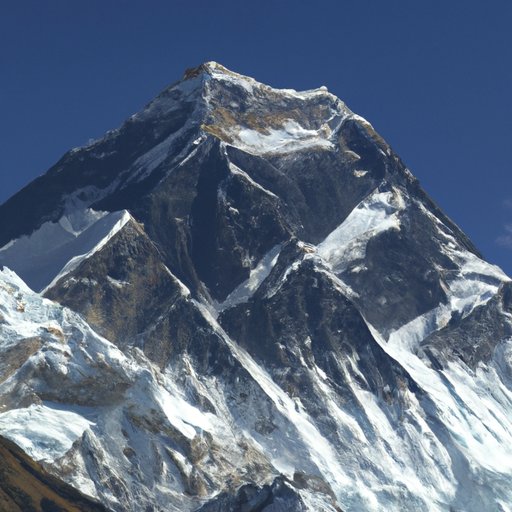Introduction
When it comes to the topic of mountains, there are many records to be broken. From the highest peak on Earth to the deepest canyons, mountains have a certain allure that draws adventurers from all over the world. But what is the largest mountain in the world?
The answer may not be as straightforward as you think. While many people assume that Mount Everest is the largest mountain on our planet, this isn’t necessarily true. The definition of “largest mountain” can actually vary depending on the criteria used to measure it. For example, some measurements might take into account total height, while others may factor in total area or volume.
In this article, we’ll explore the five largest mountains in the world according to their total height. We’ll also take a closer look at Mount Everest, the highest peak on Earth, and how it became the largest mountain in the world.
A Comprehensive Guide to the World’s Largest Mountain
Exploring the Highest Peak on Earth: What is the Largest Mountain?
As mentioned, the definition of “largest mountain” can vary depending on the criteria used to measure it. However, when most people talk about the largest mountain in the world, they are referring to the peak with the highest elevation above sea level. This means that the mountain with the highest peak on Earth is generally considered to be the largest mountain in the world.
The Top 5 Largest Mountains in the World
Let’s take a look at the five largest mountains in the world according to their total height. These are the five tallest peaks on our planet and are sure to inspire awe and admiration:
1. Mount Everest
Mount Everest is located in the Mahalangur section of the Himalayas in Nepal and Tibet. It has an elevation of 8,848 meters (29,029 feet) and is considered to be the highest mountain on Earth. It was first summited by New Zealander Edmund Hillary and Tenzing Norgay in 1953.
2. K2
K2 is located in the Karakoram mountain range on the border between China and Pakistan. It has an elevation of 8,611 meters (28,251 feet) and is the second-highest mountain on Earth. It was first summited by Italians Achille Compagnoni and Lino Lacedelli in 1954.
3. Kangchenjunga
Kangchenjunga is located in the Himalayas on the border between India and Nepal. It has an elevation of 8,586 meters (28,169 feet) and is the third-highest mountain on Earth. It was first summited by British climbers George Band and Joe Brown in 1955.
4. Lhotse
Lhotse is located in the Mahalangur section of the Himalayas in Nepal and Tibet. It has an elevation of 8,516 meters (27,940 feet) and is the fourth-highest mountain on Earth. It was first summited by Swiss climbers Ernst Reiss and Fritz Luchsinger in 1956.
5. Makalu
Makalu is located in the Mahalangur section of the Himalayas in Nepal and Tibet. It has an elevation of 8,485 meters (27,838 feet) and is the fifth-highest mountain on Earth. It was first summited by French climbers Lionel Terray and Jean Couzy in 1955.
An Overview of Mount Everest: How Did it Become the Largest Mountain?
Now that we’ve taken a look at the five highest mountains on Earth, let’s focus on Mount Everest and how it became the largest mountain in the world. To understand this, we need to take a closer look at the geographical and geological factors that make up Mount Everest.
Geographical and Geological Factors
Mount Everest is located in the Mahalangur section of the Himalayas, which is part of the Great Himalayan Range. This range stretches for almost 2,500 kilometers (1,550 miles) across Nepal, Tibet, Bhutan, and India. The Himalayas were formed by the collision of two tectonic plates—the Indian Plate and the Eurasian Plate—which created the highest mountain range on Earth.
Mount Everest itself is composed of three different rock types—sedimentary, metamorphic, and igneous—which were formed over millions of years of pressure and erosion. Its steep slopes, deep valleys, and high altitude make it one of the most challenging mountains to climb.
Climbing History
Since the early 1900s, Mount Everest has been a popular destination for mountaineers. In 1953, New Zealand climber Edmund Hillary and his Sherpa guide, Tenzing Norgay, became the first people to reach the summit of Mount Everest. Since then, thousands of people have attempted to summit the highest peak on Earth.
From Snow-Capped Peaks to Record Heights: A Closer Look at the World’s Biggest Mountain
Summit Conditions
At the summit of Mount Everest, the air is extremely thin due to the lack of oxygen at such a high altitude. Temperatures can drop to as low as -60°C (-76°F), making it one of the coldest places on Earth. Wind speeds can reach up to 200 kilometers per hour (124 mph), creating treacherous conditions for climbers.
Challenges Faced by Climbers
Climbing Mount Everest is an incredibly difficult task. Not only do climbers need to battle the harsh weather conditions, but they must also contend with altitude sickness, frostbite, and avalanches. Furthermore, due to the popularity of the mountain, climbers must often wait in long queues to reach the summit.
Conclusion
Mount Everest is the highest peak on Earth and is widely considered to be the largest mountain in the world. Its geographical and geological features make it an incredibly challenging climb, and its summit conditions are some of the harshest on the planet. Despite these challenges, thousands of people have attempted to summit the mountain since it was first summited in 1953. Understanding the history and challenges of Mount Everest is essential for anyone who wishes to attempt the climb.


